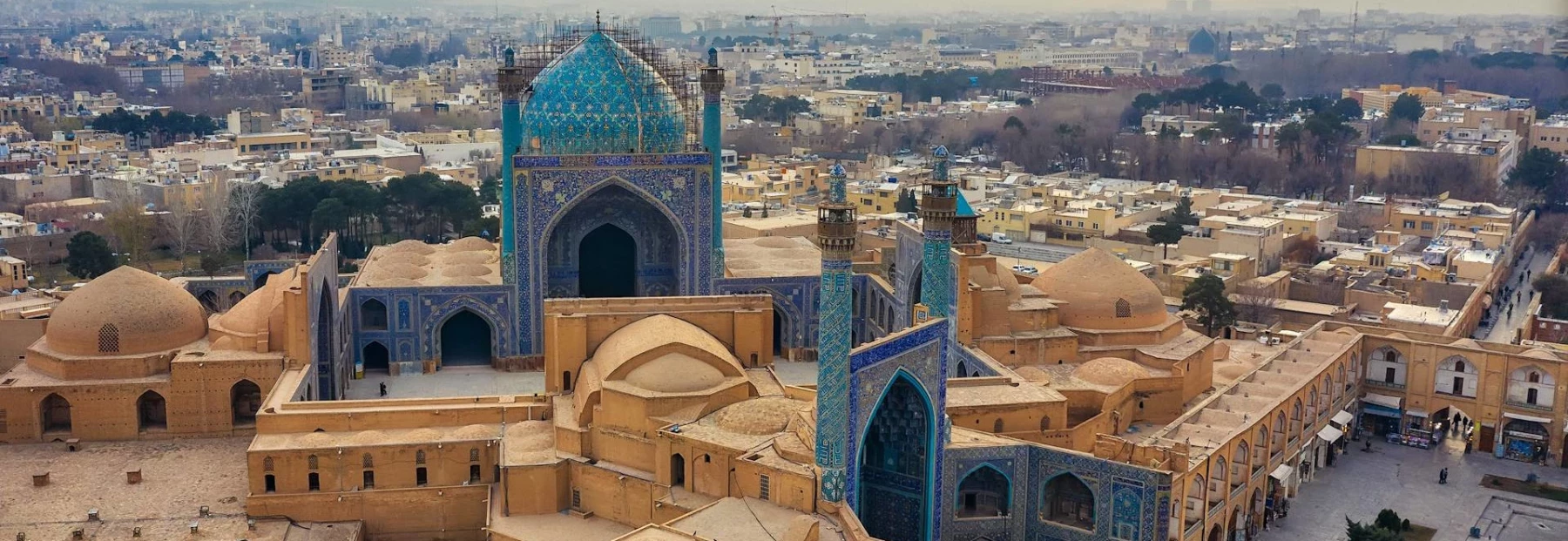To visit - Ispahan
A journey to Isfahan, an iconic city in Iran, offers a deep dive into a world of exceptional architectural and cultural beauty. At the heart of this city lies Naghsh-e Jahan Square, a vast esplanade surrounded by sumptuous monuments that bear witness to the glorious past of Persia. The Sheikh Lotfollah Mosque, with its elegant domes and vibrant ceramic tiles, evokes a mystical splendor. Nearby, the Shah Mosque, grand and majestic, stands as an impressive testament to Islamic art.
The Ali Qapu Palace, a royal palace, provides a panoramic view of the square from its elevated balcony, while its lavishly decorated halls reveal opulence worthy of the Safavid era. Roaming through Qeysarieh Bazaar, the intoxicating scents of spices and the brilliance of Persian carpets create a vibrant atmosphere.
The historic bridges of Siosepol and Khaju, spanning the Zayandeh Rud River, invite serene strolls along their banks. The Chehel Sotoun Gardens, with columns reflected in a pool, offer a peaceful escape in the heart of the city.
In the Armenian quarter of Jolfa, the Cathedral of Saint Savior, also known as Vank, charms with its vibrant frescoes depicting biblical narratives.
Every corner of Isfahan tells a story centuries old, a narrative woven through labyrinthine alleys, opulent palaces, and places of worship imbued with spirituality. Isfahan unfolds as a jewel of incomparable cultural richness, where past and present coexist harmoniously, providing travelers with a profoundly immersive experience.
The 11 essential things to do in Isfahan :
Summary
- To visit
-
- 1 - Visit Naqsh-e Jahan Square
- 2 - Explore the Imam Mosque
- 3 - Discover the Chehel Sotoun Palace
- 4 - Stroll along the Khaju Bridge
- 5 - Explore the Armenian Quarter
- 6 - Visit Vank Cathedral
- 7 - Shopping at Isfahan Bazaar
- 8 - Taste Iranian cuisine
- 9 - Relax in Sofeh Mountain
- 10 - Visit Hasht Behesht Palace
- 11 - Visit the Mausoleum of Haroun-e-Velayat
- Ispahan - Where to Stay?
- Ispahan - How to get around?
- Ispahan - Best period
1 - Visit Naqsh-e Jahan Square
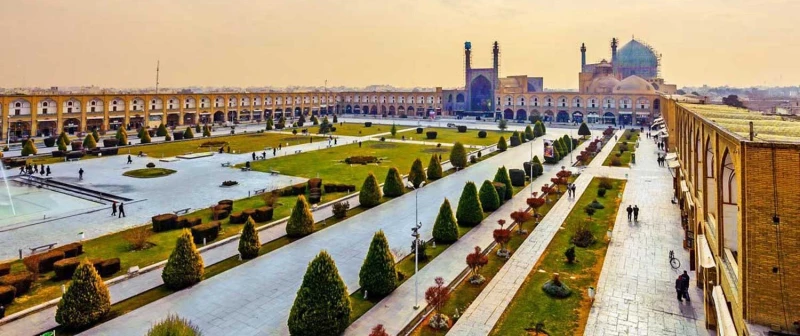
The Naqsh-e Jahan Square, a cultural gem in Isfahan, beckons me to an immersive experience at the heart of Persian history. This vast esplanade, designated a UNESCO World Heritage site, unfolds a breathtaking architectural symphony. At its center stands the Imam Mosque, a jewel of Islamic art, with its majestic minarets and mesmerizing mosaics. Adjacent to it, the Ali Qapu Palace, a Safavid-era wonder, reveals lavishly adorned chambers and provides a panoramic view of the square from its balcony. On the other side, the Sheikh Lotfollah Mosque, a masterpiece of grace and subtlety, unfurls its elegant domes. The surrounding bustling bazaars, lively and colorful, add a vibrant touch to this historic square.
The cobblestone alleys of Naqsh-e Jahan seem imbued with echoes of centuries of history, while street vendors and local musicians create a lively atmosphere. The expansive green space at the center hosts locals gathering to relax around the central fountain. In the evening, the square comes alive with illumination, creating a magical backdrop for strolling visitors who soak in the energy of this iconic site. The pigeons that populate the square add a poetic touch to this unforgettable scene. Naqsh-e Jahan is not just a square; it is a living testament to the grandeur and splendor of Persian history, an invitation to get lost in the glorious past of this enchanting city.
 Our tips for getting the most out of your experience.
Our tips for getting the most out of your experience.
To make the most of your visit to Naqsh-e Jahan Square in Isfahan, here are some tips:
-
Visit Timing: Explore the square early in the morning or late in the afternoon to avoid peak tourist hours and enjoy a more serene atmosphere.
-
Local Guides: Consider hiring a local guide for in-depth insights into the history and architecture of the surrounding monuments.
-
Comfortable Footwear: The square is expansive, so wear comfortable shoes to explore the various sites without discomfort.
-
Appropriate Attire: Ensure you dress modestly, especially if you plan to visit the mosques. Women should have a headscarf to cover their hair.
-
Time to Relax: Plan some time to sit at the center of the square, enjoy the fountain, and observe local life.
-
Avoid Midday Heat: If visiting during summer months, avoid the hottest part of the day by seeking shade and staying well-hydrated.
-
Bargain at the Bazaar: The bazaars around the square offer a unique shopping experience. Don't hesitate to negotiate prices; it's often expected.
-
Photography: Make sure to bring your camera. Naqsh-e Jahan Square is picturesque, especially during sunset.
-
Pre-knowledge: Read up a bit on the history of the square before visiting to fully appreciate the cultural significance of the monuments.
-
Attend Local Events: If possible, find out if there are any local cultural events or festivals happening on the square during your stay.
-
Respectful Behavior: Respect local rules and customs, especially in places of worship. Refrain from taking photos where it's not allowed.
By following these tips, you'll be able to make the most of your visit to Naqsh-e Jahan Square and have a rewarding experience in Isfahan.
2 - Explore the Imam Mosque
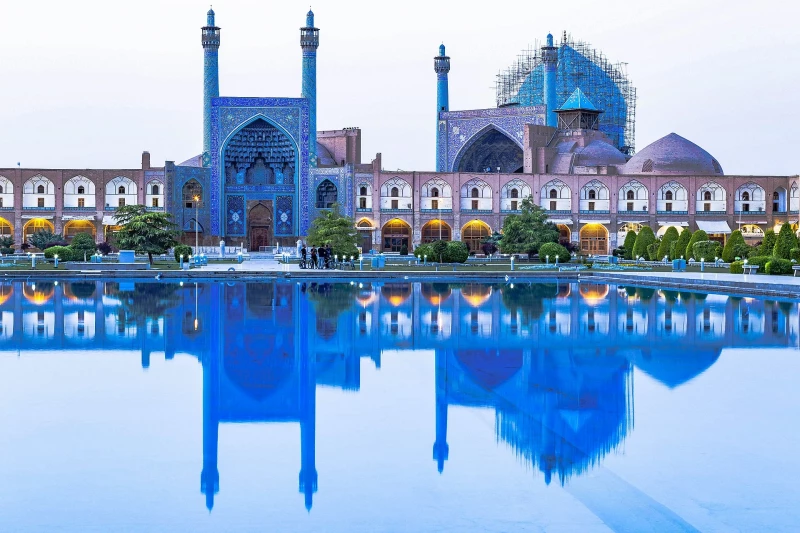
The Imam Mosque, also known as Shah Mosque, stands as an architectural masterpiece at the heart of Naqsh-e Jahan Square in Isfahan. Its awe-inspiring beauty is immediately evident as one approaches its grand entrance adorned with intricate tilework and calligraphy. The mosque, constructed during the Safavid era, showcases a mesmerizing blend of Persian, Islamic, and Central Asian architectural elements.
Stepping inside, visitors are greeted by a vast courtyard surrounded by elegant iwans, leading to the main prayer hall. The sheer scale of the mosque is complemented by the meticulous details of its tile mosaic, portraying floral patterns and calligraphy that echo verses from the Quran. The iconic turquoise dome, with its intricate geometric designs, adds a celestial touch to the entire structure.
One of the most captivating features is the acoustics of the mosque's dome and chambers, which are said to amplify prayers and chants. The play of light and shadow within the prayer hall, especially during sunrise and sunset, enhances the spiritual ambiance. The exquisite minarets rise gracefully, offering panoramic views of the square and the city.
The Sheikh Lotfollah Mosque, adjacent to the Imam Mosque, complements its grandeur with its intimate charm. The Imam Mosque stands not only as a place of worship but as a testament to the artistic and architectural brilliance of the Safavid dynasty, inviting visitors to immerse themselves in the rich history and spiritual aura that permeate its sacred walls.
 Our tips for getting the most out of your experience.
Our tips for getting the most out of your experience.
For an enriching exploration of the Imam Mosque in Isfahan, here are some practical tips:
-
Appropriate Dress Code: Dress modestly, especially if you're a woman. Bring a headscarf to cover your hair.
-
Visiting Hours: Opt for early morning or late afternoon hours to avoid crowds and experience the tranquility of the place.
-
Local Guide: Consider hiring a local guide for a more in-depth tour and to understand the history and spiritual significance of the mosque.
-
Respect Prayer Areas: Be respectful of those who are praying. Avoid disrupting ongoing prayer sessions.
-
Photography Rules: Check the rules regarding photography inside the mosque. Certain areas may be off-limits or require special permission.
-
Footwear: Remove your shoes at the entrance, following Islamic tradition. Bring clean and comfortable socks.
-
Explore Surroundings: Take time to explore the surroundings of the mosque, including the courtyard and architectural details. Each element tells a unique story.
-
Attend a Prayer: If possible, attend a prayer session to experience the spiritual atmosphere and religious fervor of this holy place.
-
Guided Tour Schedule: Inquire about guided tour schedules organized by the mosque. This can provide you with additional insights.
-
Appreciate Art: Take the time to appreciate the artistic details of the mosaics, calligraphy, and geometric patterns present in the mosque.
-
Respect Silence: Maintain a respectful demeanor by keeping noise levels low, especially in prayer areas.
-
Prior Knowledge: Before your visit, familiarize yourself with the history of the mosque to better understand its cultural and historical significance.
By following these tips, you can have a more enriching and respectful experience during your exploration of the Imam Mosque in Isfahan.
3 - Discover the Chehel Sotoun Palace
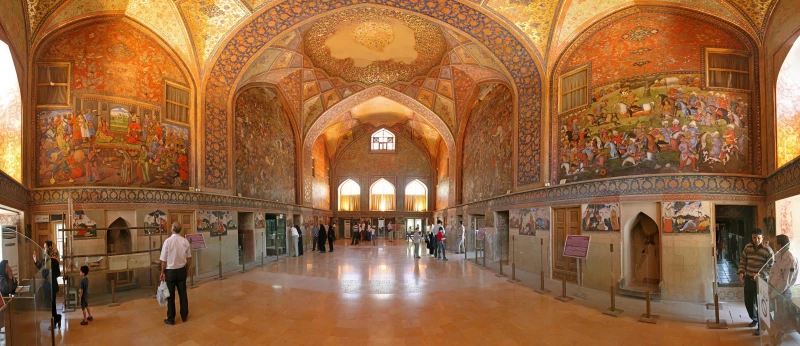
Chehel Sotoun Palace, located in Isfahan, is an architectural marvel that transports its visitors to the opulence of the Safavid era. Built in the 17th century, the palace derives its name from the forty columns of its impressive reception hall, mirrored in the pool in front of it. The elegance of the architecture is magnified by exceptional mural paintings adorning the palace walls, depicting scenes of battles, ceremonies, and the royal court. The surrounding garden, meticulously landscaped, offers a peaceful escape, with shaded pathways and fountains.
Inside the palace, the Chehel Sotoun reception hall captivates with its regal atmosphere, featuring richly adorned pillars and mirrored ceilings. Visitors can marvel at the spectacular frescoes that bring to life the history and grandeur of the Safavid dynasty. The extensive palace gardens, planted with cypresses and roses, invite contemplation, creating an enchanting contrast with the majestic architecture of the palace. Chehel Sotoun Palace thus unfolds as a historical and artistic treasure, providing a captivating glimpse into the splendor of 17th-century Iran.
 Our tips for getting the most out of your experience.
Our tips for getting the most out of your experience.
For a successful exploration of Chehel Sotoun Palace in Isfahan, here are some practical tips:
-
Opening Hours: Check the palace's opening hours before your visit to plan your day effectively.
-
Guided Tour: Consider taking a guided tour to gain in-depth insights into the history, architecture, and artistic details of the palace.
-
Comfortable Attire: Wear comfortable clothing and suitable shoes, as you may spend time walking in the palace gardens.
-
Respect Rules: Adhere to the palace rules, such as restrictions on photography in certain areas, to ensure a respectful and enjoyable experience.
-
Enjoy the Gardens: Take the time to explore the extensive gardens surrounding the palace. They offer peaceful corners and stunning views of the palace.
-
Visit Timing: Opt for a visit early in the morning or late in the afternoon to avoid the midday heat and take advantage of the best lighting for photos.
-
Pre-Knowledge: Read about the history of the palace before your visit to better appreciate the artistic and historical details you will encounter.
-
Listen to Narratives: If you choose a guided tour, listen attentively to the narratives and anecdotes that add a lively dimension to your experience.
-
Check for Exhibitions: See if there are any temporary exhibitions or special events organized at the palace during your visit.
-
Ideal Timing: If possible, visit the palace in spring when the gardens are in full bloom, creating an even more magical atmosphere.
-
Respect Nature: Be respectful of nature by avoiding walking on flower beds or disturbing wildlife.
By following these tips, you'll maximize your exploration experience at Chehel Sotoun Palace and fully appreciate the richness of this historical and artistic site.
4 - Stroll along the Khaju Bridge
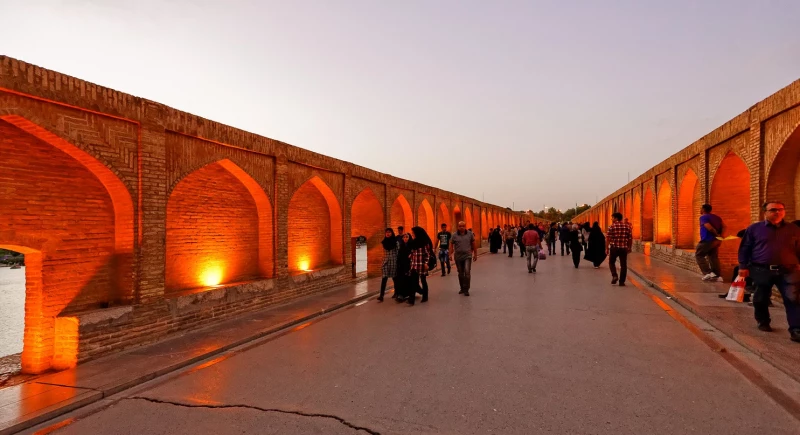
A stroll along Khaju Bridge in Isfahan offers a poetic experience, blending history, architecture, and the tranquil atmosphere of the Zayandeh River. Built in the 17th century, this symmetrical bridge gracefully spans the river, combining elegant arches with a paved platform. As one ambles along the bridge, a panoramic view of the city and surrounding mountains unfolds, creating a captivating visual backdrop.
The pavilions in the middle of the bridge add an artistic dimension, providing shaded retreats where visitors can pause to enjoy the view, meditate, or listen to local musicians who often perform there. In the summer, the reflection of the bridge in the water, coupled with the lush riverbanks, creates a scene infused with serenity.
Evenings at Khaju Bridge are particularly enchanting when the lights come on, and local residents and visitors gather to enjoy the cool breeze. The reflections of the lights in the water create a fairy-tale ambiance, while lively conversations and musical notes waft through the air.
This walk along Khaju Bridge is more than just crossing the river; it becomes an immersive experience, capturing the essence of history and daily life unfolding along the banks of ancient and timeless Isfahan.
 Our tips for getting the most out of your experience.
Our tips for getting the most out of your experience.
For an optimal experience during your stroll along Khaju Bridge in Isfahan, here are some practical tips:
-
Time of Day: Preferably, choose a walk in the late afternoon or evening to enjoy the magical lights and avoid the daytime heat.
-
Comfortable Shoes: Wear comfortable shoes as you might be tempted to wander and explore the surroundings.
-
Photography: Don't forget your camera, especially if you're visiting in the evening. The bridge lights and reflections in the water offer unique photographic opportunities.
-
Detour to the Pavilions: Explore the pavilions in the middle of the bridge for a different view and to soak in the artistic atmosphere.
-
Listen to Local Music: Keep an ear out for local musicians who may play traditional music on the bridge. It's a pleasant auditory experience.
-
Meet Locals: Take the opportunity to interact with locals who often gather on the bridge. This can provide interesting local perspectives.
-
Respect the Environment: Be respectful of the environment and fellow walkers. Keep the area clean and avoid disrupting the tranquility.
-
Sunset Viewing: If weather permits, plan your walk to capture the beautiful sunset from the bridge.
-
Learn About the History: Familiarize yourself with the history of Khaju Bridge before your walk for a deeper appreciation of this historical site.
-
Take Your Time: Don't rush. Take your time to appreciate the view, sounds, and the unique atmosphere of this iconic location.
By following these tips, your stroll along Khaju Bridge will not only be enjoyable but also an enriching immersion into the history and culture of Isfahan.
5 - Explore the Armenian Quarter
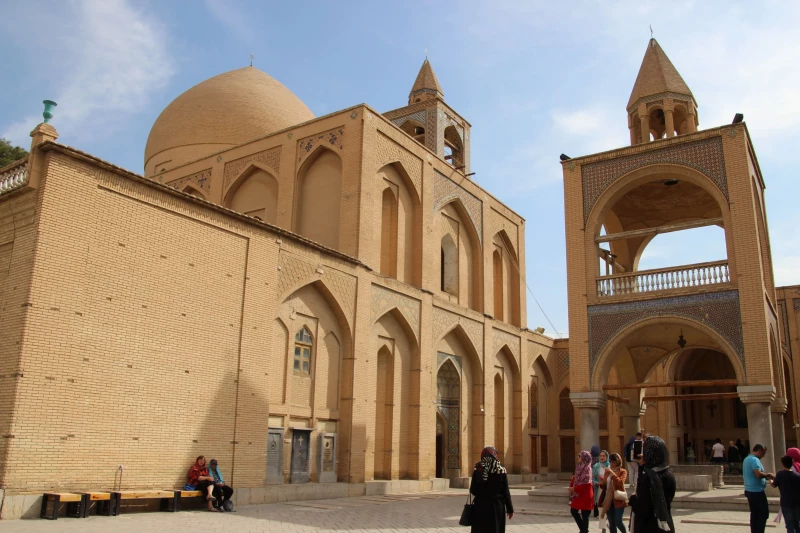
The Armenian Quarter in Isfahan unfolds as a cultural enclave rich in history and diversity. At the heart of this community, the Vank Cathedral, a 17th-century architectural gem, beckons visitors with its vibrant frescoes depicting biblical and historical scenes. The cobbled streets of the quarter invite leisurely strolls, revealing churches, schools, and traditional houses adorned with intricate facades.
Artisan shops offer unique souvenirs, while cafes and restaurants serve delicious Armenian cuisine. The Megerian Library, housing a collection of ancient manuscripts, attests to the intellectual heritage of the community. The warmth of the locals enhances the experience, providing visitors with the opportunity to immerse themselves in Armenian daily life.
The Armenian Museum of Isfahan displays precious artifacts, allowing a deep dive into the history of this community. Religious ceremonies, especially during festivals, provide insight into the spiritual fervor that animates this quarter. Exploring the Armenian Quarter in Isfahan becomes a journey through time, where architecture, art, cuisine, and human warmth converge to create an unforgettable cultural experience.
 Our tips for getting the most out of your experience.
Our tips for getting the most out of your experience.
For an enriching exploration of the Armenian Quarter in Isfahan, here are some practical tips:
-
Guided Tour: Consider taking a guided tour to gain in-depth insights into the history, architecture, and culture of the quarter.
-
Opening Hours: Check the opening hours of churches, museums, and other points of interest to plan your visit optimally.
-
Meet the Locals: Be open to interacting with the locals. The Armenian Quarter is known for its hospitality, and locals may share fascinating stories.
-
Culinary Exploration: Don't miss tasting Armenian cuisine at local restaurants. Ask for recommendations to discover authentic dishes.
-
Exploration on Foot: The cobbled streets and alleyways of the quarter invite walking. Take the time to explore on foot to discover hidden corners and architectural details.
-
Visit Churches: Explore several churches, including the Vank Cathedral. Admire the architecture and discover the artistic and spiritual treasures inside.
-
Artisan Shops: Take a stroll through artisan shops to purchase unique souvenirs. Handcrafted items can provide insight into traditional Armenian craftsmanship.
-
Local Events: Inquire about any local events or festivals that may take place in the quarter during your visit.
-
Respect Places of Worship: If you visit churches, ensure you respect the rules and decency appropriate for these places of worship.
-
Pre-Reading: Read a bit about Armenian history before your visit to better understand the cultural and historical context of the quarter.
By following these tips, your exploration of the Armenian Quarter in Isfahan will not only be enjoyable but also a deeper immersion into this unique community.
6 - Visit Vank Cathedral
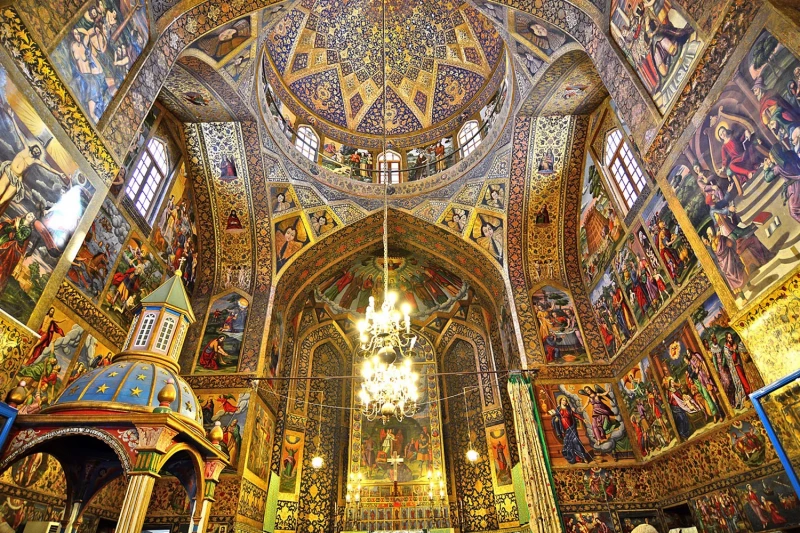
The Vank Cathedral, nestled in the heart of Isfahan's Armenian Quarter, stands as a historical and artistic treasure from the 17th century. Its unassuming exterior belies the opulence within. Upon entering, visitors are greeted by spectacular frescoes adorning every inch of the walls. These frescoes, a vibrant blend of colors and intricate details, narrate biblical stories and key moments in Armenian history.
The cathedral's architecture seamlessly blends Armenian, Persian, and Ottoman elements, creating a unique sanctuary that reflects Isfahan's multicultural heritage. The echoes of prayers from ages past seem to resonate within the sacred enclosure, creating an enchanting spiritual atmosphere. Carved wooden ornaments, sparkling chandeliers, and carefully arranged carpets add to the interior splendor of the cathedral.
Visitors can also explore the adjacent museum, housing precious religious and cultural artifacts, providing an even deeper dive into Armenian history. The Vank Cathedral, with its unique amalgamation of art, architecture, and spirituality, remains a must-visit site for those seeking to understand the rich cultural diversity of Isfahan.
 Our tips for getting the most out of your experience.
Our tips for getting the most out of your experience.
For an enriching visit to the Vank Cathedral in Isfahan, here are some practical tips:
-
Opening Hours: Check the opening hours before your visit to plan your day accordingly.
-
Local Guide: Consider hiring a local guide for a more in-depth tour. Guides can provide valuable historical and cultural insights.
-
Admire the Frescoes: Take the time to appreciate the spectacular frescoes adorning the cathedral walls. Each detail tells a captivating story.
-
Respect the Tranquility: As the cathedral is a place of worship, maintain a low noise level to respect the tranquility of the space.
-
Explore Architectural Details: Note the unique architectural details of the cathedral, reflecting the influence of different cultures in its design.
-
Visit the Museum: Explore the adjacent museum to discover religious and cultural artifacts that will enhance your understanding of Armenian history.
-
Appropriate Attire: Dress modestly as you enter the cathedral. Avoid overly casual attire.
-
Photograph with Consideration: If photography is allowed, take pictures with consideration, avoiding disturbing other visitors.
-
Appreciate the Spirituality: Take a few moments to immerse yourself in the spiritual atmosphere of the cathedral, contemplating if you wish.
-
Engage with Locals: If parishioners or cathedral officials are available, don't hesitate to engage with them for local perspectives.
By following these tips, you can have a comprehensive and respectful experience during your visit to the Vank Cathedral in Isfahan.
7 - Shopping at Isfahan Bazaar
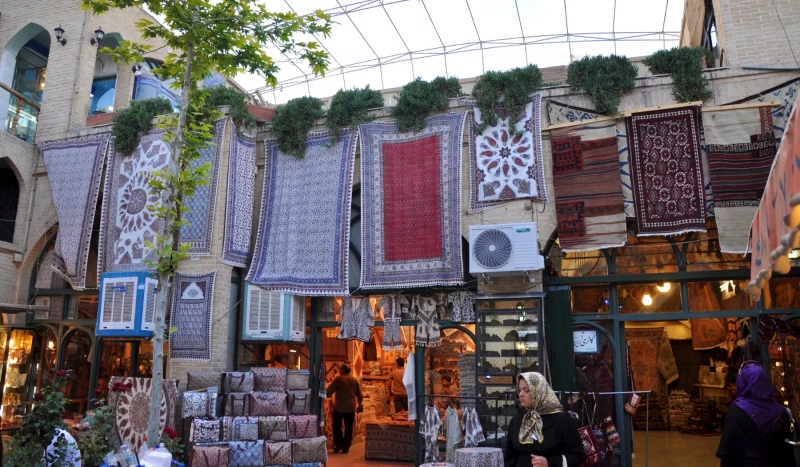
Shopping at the bazaar in Isfahan provides a captivating experience infused with Persian history and culture. While navigating its narrow alleys and shaded arcades, one discovers an endless variety of artisanal products, from exquisite Persian carpets to traditional pottery and sparkling jewelry. Street vendors offer fragrant spices, vibrant fabrics, and unique souvenirs.
The Carpet Bazaar is a must-visit, showcasing a range of patterns and colors, each telling a cultural story. Friendly negotiations with merchants are an integral part of the experience, creating a lively and welcoming atmosphere. Craft enthusiasts can explore hand-hammered copper items, delicate Persian miniatures, and much more.
Tip: Be prepared to haggle, as it's a common practice in Persian bazaars. Take your time, explore hidden corners, and immerse yourself in the art of shopping in the heart of historic Iran.
 Our tips for getting the most out of your experience.
Our tips for getting the most out of your experience.
For a successful shopping experience at the Isfahan bazaar, here are some practical tips:
-
Master the Art of Bargaining: Negotiation is an integral part of the buying process in Persian bazaars. Be prepared to negotiate prices amicably to secure good deals.
-
Be Ready to Explore: Isfahan's bazaars are vast with numerous small shops. Take the time to explore hidden corners to discover unique treasures.
-
Engage with Merchants: Interact with vendors in a friendly manner. Ask questions about the products, their history, and their craftsmanship. This can enhance your overall experience.
-
Know the Quality of Products: Familiarize yourself with the quality of products you intend to buy, especially for items like carpets, jewelry, or textiles.
-
Avoid Peak Hours: If possible, plan your visit during off-peak hours to avoid crowds and enjoy a more peaceful shopping experience.
-
Carry Cash: While some places may accept credit cards, it's advisable to have cash on hand, especially when negotiating prices.
-
Wear Comfortable Clothing: You might spend a considerable amount of time walking and exploring. Comfortable clothing and appropriate shoes are essential.
-
Taste Local Specialties: Seize the opportunity to taste local delights. Many bazaars have food stalls offering snacks and traditional dishes.
-
Be Culturally Aware: Respect local culture in terms of behavior and dress. This can contribute to a positive shopping experience.
-
Inspect Products: Before making a purchase, carefully inspect the products to ensure their quality. This is particularly important for handmade items.
By following these tips, your shopping experience at the Isfahan bazaar will not only be productive but also culturally enriching.
8 - Taste Iranian cuisine
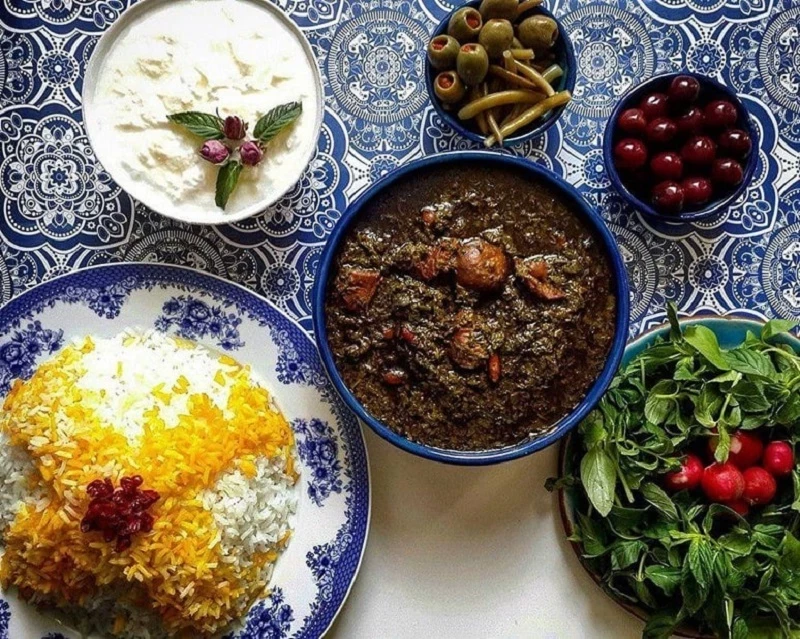
Iranian cuisine is a rich sensory experience, infused with flavors, aromas, and traditions that span centuries. One undeniable star is chelo kebab, a delightful combination of spiced rice and grilled meat skewers, often served with saffron and fresh herbs. Fesenjan, a stew made with walnuts, pomegranates, and meat, offers an explosion of sweet and tangy flavors.
Fresh herbs like mint and cilantro are ubiquitous, adding a refreshing touch to many dishes. Rice dishes, such as tahchin, a saffron and yogurt-infused rice cake, are aromatic and complex delights. Let's not forget about delicious desserts like halva and pistachio pastries.
Soups, like ash reshteh, a noodle soup with herbs, are comforting and nutritious. Iranian dishes are often accompanied by flatbread, lavash, perfect for complementing various mezzes and cheeses. Traditional drinks include strong black tea and doogh, a yogurt-based beverage. Exploring Iranian cuisine unveils a symphony of flavors, reflecting the history and diversity of this captivating culinary landscape.
 Our tips for getting the most out of your experience.
Our tips for getting the most out of your experience.
For a memorable culinary experience of Iranian cuisine in Isfahan, here are some practical tips:
-
Discover Local Restaurants: Venture away from touristy areas and explore local alleys to find authentic restaurants. These places can offer a more genuine experience.
-
Try Local Specialties: Don't miss out on tasting traditional Isfahani dishes such as Biryani, Khoresht-e-Mast (yogurt stew), and various kebabs.
-
Engage in Conversation with Locals: Ask locals for recommendations. They will be delighted to share their favorite spots for authentic cuisine.
-
Take a Cooking Class: If possible, enroll in a local cooking class. It's a great way to learn how to prepare Iranian dishes yourself.
-
Explore Food Markets: Visit local markets to discover fresh ingredients and get an insight into the variety of products used in Iranian cuisine.
-
Be Open to Street Food: Don't hesitate to try street food offered by vendors. Often, this is where you'll find authentic flavors.
-
Indulge in Traditional Desserts: Conclude your meal with traditional desserts like Zoolbia-Bamieh or Faloudeh for a distinctly Iranian sweet experience.
-
Sample Local Drinks: Don't miss tasting Iranian tea, often served strong and fragrant. Also, try traditional drinks like ayran.
-
Meal Timing: Respect local meal times. Restaurants may be livelier during traditional meal hours.
-
Explore Different Neighborhoods: Isfahan has a variety of neighborhoods, each with its own culinary specialties. Explore different areas for a gastronomic diversity.
By following these tips, you can fully appreciate the richness of Iranian cuisine in Isfahan, combining delicious flavors with unique culinary traditions.
9 - Relax in Sofeh Mountain
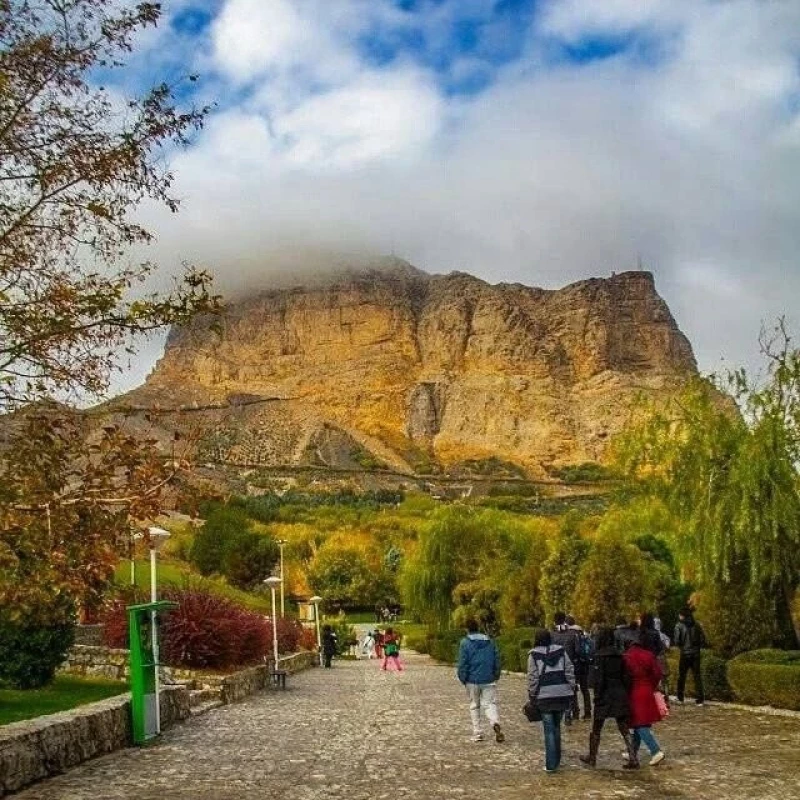
The Sofeh Mountain, located near Isfahan, offers a tranquil retreat and a refreshing natural getaway. To relax in this mountainous environment, start with a leisurely hike along winding trails that traverse picturesque landscapes. The panoramic views from the mountain's heights provide a breathtaking spectacle, with Isfahan sprawling below.
Find a quiet spot to sit and meditate, enjoying the serenity of nature. Lush trees and the scents of the mountain create a soothing atmosphere. For an even more relaxing experience, bring a picnic and settle down in one of the designated areas.
Photography enthusiasts can capture the natural beauty of the mountain, while those seeking more active relaxation can opt for outdoor activities like yoga. In winter, Sofeh Mountain transforms into a snowy playground, adding a magical dimension to your getaway.
Whether for a day of relaxation or a weekend escape, Sofeh Mountain offers a welcome break from the hustle and bustle of daily life, allowing visitors to recharge amidst the majestic nature of central Iran.
 Our tips for getting the most out of your experience.
Our tips for getting the most out of your experience.
For a relaxed experience in Sofeh Mountain near Isfahan, here are some practical tips:
-
Choose the Right Time of Day: Opt for sunrise or sunset to enjoy spectacular views and a quieter ambiance.
-
Bring Provisions: Pack a light picnic with snacks and drinks to enjoy an outdoor meal at the mountain's summit.
-
Comfortable Clothing: Wear comfortable clothing and hiking shoes to facilitate exploration of hiking trails.
-
Picnic Blanket: Bring a mat or blanket to create a comfortable space to sit and relax.
-
Prepare a Soothing Playlist: If you enjoy music, create a relaxing playlist to listen to during your nature escapade.
-
Outdoor Yoga: If you practice yoga, bring a foldable mat and enjoy a session outdoors for mental and physical relaxation.
-
Sun Protection: If visiting during the day, don't forget to apply sunscreen and wear a hat to protect yourself from the sun.
-
Hydration: Ensure you have an ample supply of water, especially if planning to hike or engage in physical activities.
-
Camera or Smartphone: Capture memorable moments with a camera or smartphone to immortalize the natural beauty.
-
Respect the Environment: Be respectful of nature. Avoid leaving any waste behind and follow park or mountain rules.
By following these tips, you can fully enjoy a relaxing experience in Sofeh Mountain, in harmony with the surrounding nature.
10 - Visit Hasht Behesht Palace
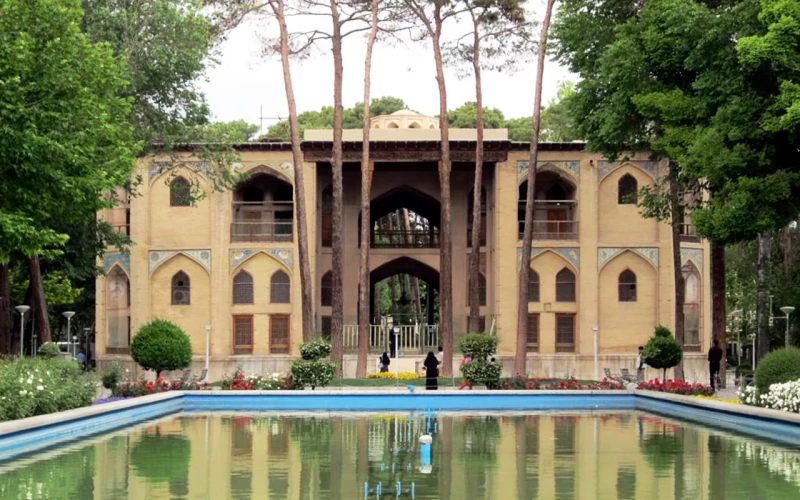
The Hasht Behesht Palace, located in Isfahan, is a 17th-century architectural masterpiece that provides a captivating glimpse into the Safavid era of Persia. Built during the reign of Abbas II, this enchanting palace gets its name from the Persian paradise, symbolized by the "eight paradises" in Islamic culture.
The majestic entrance of the palace unveils lush gardens and fountains, creating a serene atmosphere. The refined architecture showcases a harmonious fusion of Persian and European elements, illustrating the cultural influence of the time. Tiled mosaics adorn the walls, narrating visual stories with floral and geometric patterns.
Inside, the richly decorated rooms bear witness to the luxury of the Safavid era. Mirrors and chandeliers add a touch of elegance, creating a magical brightness. Finely carved wooden ceilings and sumptuous carpets contribute to the opulence.
 Our tips for getting the most out of your experience.
Our tips for getting the most out of your experience.
For an enriching visit to the Hasht Behesht Palace in Isfahan, here are some practical tips:
-
Pre-Research: Before visiting, familiarize yourself with the history and architecture of the palace to better appreciate each detail.
-
Choose the Right Time: Prefer a visit early in the morning or late afternoon to avoid crowds and benefit from a quieter atmosphere.
-
Guided Tour: Consider taking a guided tour to gain in-depth insights into the history, art, and culture associated with the palace.
-
Explore the Gardens: The gardens surrounding the palace are beautiful. Take the time to explore the outdoor spaces and enjoy the tranquility.
-
Observe Architectural Details: Examine the tiled mosaics, floral patterns, and finely carved ceilings to appreciate the art and craftsmanship of the period.
-
Photography with Respect: If photography is allowed, take pictures while respecting the integrity of the place and other visitors.
-
Follow Site Rules: Adhere to the rules of the palace, including accessible areas and any potential restrictions.
-
Wear Comfortable Shoes: You might spend time walking, so ensure you have comfortable shoes for exploration.
-
Pay Attention to Artistic Details: The artistic details inside the palace are numerous. Pay attention to frescoes, chandeliers, and period furniture.
-
Take Your Time: Don't rush. Take the time to appreciate each room and immerse yourself in the historical atmosphere of the palace.
By following these tips, your visit to the Hasht Behesht Palace will not only be informative but also a culturally and artistically enriching experience.
11 - Visit the Mausoleum of Haroun-e-Velayat
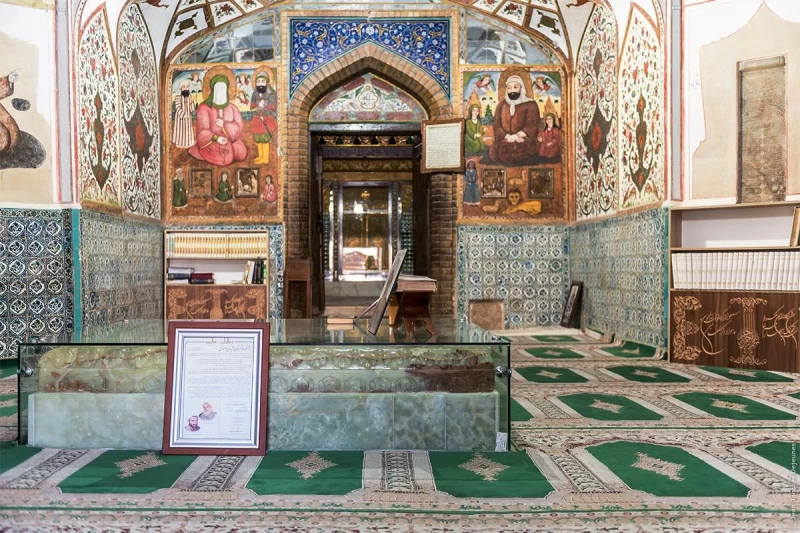
The Mausoleum of Haroun-e-Velayat, located in Isfahan, is a place imbued with spirituality and history. Built in honor of Haroun-e-Velayat, a descendant of the seventh Shiite Imam, this mausoleum attracts visitors with its sacred architecture.
At the entrance, visitors are welcomed by a beautiful facade adorned with azulejos and Islamic motifs. The interior of the mausoleum is adorned with luxurious Persian carpets and mirrors that create a pious atmosphere.
Worshippers come here to pray and meditate, while visitors can appreciate the serenity of the place. The central dome of the mausoleum is an impressive architectural work, symbolizing the connection between heaven and earth.
The surroundings of the mausoleum offer peaceful spaces for contemplation, with well-maintained gardens and fountains. Visitors can learn more about the history of the mausoleum through inscriptions and explanations provided by the site's staff.
Tip: Before visiting, familiarize yourself with local customs and peak hours to fully enjoy the spiritual and cultural experience that the Mausoleum of Haroun-e-Velayat offers to visitors.
 Our tips for getting the most out of your experience.
Our tips for getting the most out of your experience.
For an enriching visit to the Mausoleum of Haroun-e-Velayat in Isfahan, here are some practical tips:
-
Respect Religious Customs: As it is a place of worship, ensure to respect religious customs by wearing modest clothing and avoiding any inappropriate behavior.
-
Visiting Hours: Check the opening hours of the mausoleum and plan your visit accordingly, considering prayer times and peak periods of attendance.
-
Local Guides: Hire a local guide to gain in-depth explanations about the history, cultural significance, and rituals associated with the mausoleum.
-
Photography: Respect the rules regarding photography. Some religious places may have restrictions, so ask for permission before taking pictures.
-
Explore the Surroundings: Take the time to explore the gardens and surroundings of the mausoleum, often imbued with tranquility and beauty.
-
Observing Rituals: If religious rituals are taking place, observe them discreetly and respectfully without disrupting worshipers.
-
Learn About the History: Before your visit, familiarize yourself with the history of the mausoleum. This will enhance your experience by better understanding the cultural and religious context.
-
Participate in Ceremonies: If ceremonies or prayers are open to visitors, consider participating in a respectful manner.
-
Appropriate Dress: Wear modest and covering clothing, especially if you plan to enter the mausoleum.
-
Respect Tranquility: Keep your voice low and avoid loud behavior to respect the tranquility of the place.
By following these tips, you can fully enjoy your visit to the Mausoleum of Haroun-e-Velayat while respecting the sacred nature of this location.
Ispahan - Where to Stay?
In Isfahan, the choice of accommodation often depends on individual preferences, budget, and the type of experience you're seeking. Here are some popular neighborhoods and types of accommodation in Isfahan:
-
Imam Square (Naghsh-e Jahan Square): Staying near Naghsh-e Jahan Square puts you in the heart of the action, surrounded by iconic monuments. Here, you'll find hotels of various categories, offering spectacular views and easy access to the main attractions.
-
Jolfa Quarter: Jolfa is the Armenian quarter of Isfahan, known for its historical charm. Guesthouses, charming hotels, and inns offer a unique experience, often associated with quieter and picturesque atmospheres.
-
Chahar Bagh Quarter (Chahar Bagh-e Abbasi): This neighborhood is known for Chahar Bagh Avenue, lined with trees, and hosts luxury hotels and upscale establishments. It's an ideal choice if you're looking for more exclusive and comfortable accommodation.
-
Azadi Quarter: Azadi Quarter is a more modern choice, with accommodation options ranging from chain hotels to boutique establishments. It can offer a balance between contemporary amenities and easy access to historical sites.
-
Zayandeh Rud Riverbank: Some hotels and guesthouses line the banks of the Zayandeh Rud River, offering peaceful views and the opportunity to enjoy the nearby historic bridges.
-
Traditional Options (Caravanserais or Traditional Houses): For a more authentic experience, you can opt for a stay in a restored caravanserai or a traditional house (like Khan-e Zaman), providing immersion into local architecture.
Make sure to book in advance, especially during the high tourist season, and check online reviews to ensure the accommodation aligns with your expectations. Accommodation choices in Isfahan are diverse, allowing visitors to find one that best suits their needs and travel style.
Ispahan - How to get around?
In Isfahan, there are several transportation options available to facilitate your movement around the city. Here are some common means of transportation in Isfahan:
-
Walking: The old city of Isfahan, especially around Naghsh-e Jahan Square, is ideal for exploring on foot. Many tourist sites, markets, and attractions are within walking distance.
-
Taxi: Taxis are widely available in Isfahan. You can hail a taxi on the street or find them at designated taxi stands. Make sure to agree on the fare with the driver before getting into the taxi, as taxis usually do not have meters.
-
Bus: Isfahan has a public bus network that covers different parts of the city. Buses can be an economical way to get around, but schedules may be less frequent and less accommodating to tourists' needs.
-
Car Rental: Car rental is an option if you want to explore areas further from Isfahan or plan excursions in the surrounding areas. Make sure to have the necessary documents and familiarize yourself with local driving conditions.
-
Mopeds and Bicycles: Some places offer moped or bicycle rentals, which can be a pleasant way to get around, especially in less crowded neighborhoods.
-
Horse-Drawn Carriages: Around Naghsh-e Jahan Square, you can find horse-drawn carriages. This is a romantic and picturesque option to explore the historic center.
-
Ridesharing: Ridesharing applications can also be used in Isfahan for more convenient transportation. Make sure you have internet access on your phone.
It's important to note that the old city of Isfahan, especially around Naghsh-e Jahan Square, is mostly pedestrian, and it's often more enjoyable to explore on foot to fully immerse yourself in the local atmosphere. Use a combination of these transportation methods based on your needs and the places you want to visit.
Ispahan - Best period
The best time to visit Isfahan depends on your climatic preferences and planned activities. Here's a breakdown of the different seasons in Isfahan:
-
Spring (March to May): Spring is often considered the best time to visit Isfahan. The temperatures are pleasant, with sunny days and mild nights. The city's gardens, like Chehel Sotoun, are in full bloom, creating beautiful landscapes.
-
Summer (June to August): Summers in Isfahan can be very hot, with temperatures often exceeding 40°C (104°F). It's the peak tourist season, but the intense heat can make visits in the midday less comfortable. Evenings are generally cooler.
-
Autumn (September to November): Autumn is another pleasant time to visit Isfahan. Temperatures start to cool down but remain comfortable. It's a good time for exploring the city and participating in local festivals.
-
Winter (December to February): Winters in Isfahan are typically mild during the day, but nights can be cool. Daytime temperatures often range between 10°C and 15°C (50°F to 59°F). It's a less crowded period for tourists, but it can get quite chilly, especially at night.
In summary, spring and autumn generally offer the most pleasant weather conditions for visiting Isfahan, with moderate temperatures and favorable weather. If you prefer warmer temperatures despite the summer crowds, summer can also be an option, while winter may provide a quieter but cooler period.
